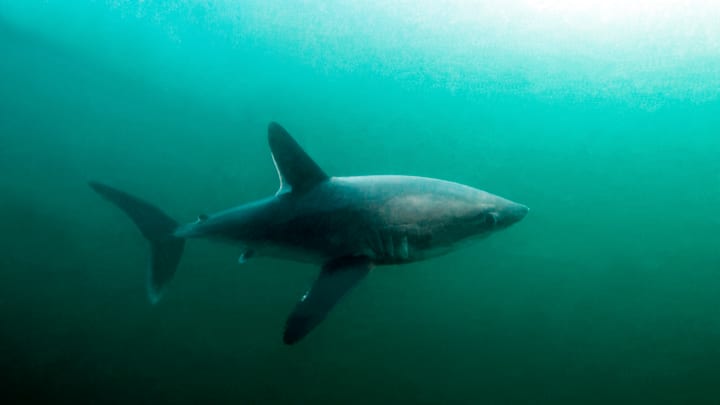A team of U.S.-based scientists made a surprising discovery about shark predation while tracking porbeagle sharks in the Atlantic Ocean. To determine where the marine animals give birth, the researchers got caught up in a murder case of one of their 7-foot specimens. The likely culprit was a great white, making it the first instance of a porbeagle shark being eaten by another large, predatory animal ever recorded.
Their findings were published in the journal Frontiers. The scientists tagged 11 porbeagle sharks in total in 2020 and 2022. The mystery started to unravel when one of two tracker tags from a pregnant porbeagle shark floated to the surface just 158 days after it was attached. The tag was designed to stay on the animal for at least a year, which drew suspicion. Additionally, a second tag that sent signals every time the shark’s fin rose above water stopped working.
Obviously, something wasn’t right, so the scientists looked at the data from the dislodged tag. They found that the depth and temperature reports from the porbeagle shark became abnormal after about five months. Initially, the shark dove between 330 and 660 feet during the night and 1970 to 2625 feet during the day in waters ranging from 43.5° and 74.3° Fahrenheit. “All of a sudden, the temperature spiked, even at 600 meters [1970 feet] depth, and stayed elevated,” study co-author Brooke Anderson told NBC News. The tagged shark’s diving pattern also changed abruptly.
With this evidence, the researchers concluded that the specimen had been devoured by a larger animal that excreted the tracking device days later. More specifically, the scientists believe that the shark responsible was either a great white shark or a shortfin mako. Both are large enough to eat porbeagles and occupy the same waters as the species. However, researchers believe that the great white shark is the more likely candidate as the typical diving patterns of shortfin makos weren’t reflected in the tracking information.
According to the researchers, this is the first documented example of a porbeagle shark being eaten by a larger predator. People typically view large sharks as top predators that are never preyed upon, but this study proves otherwise. More investigation is required to determine if the shark-on-shark attack was a fluke or part of a larger pattern.
Read More About Sharks:
